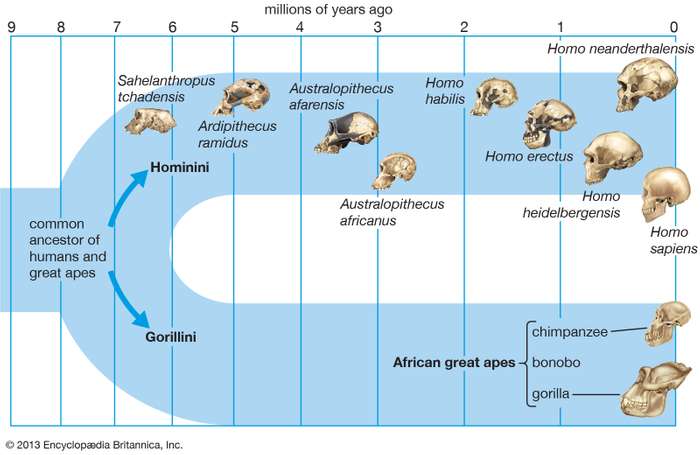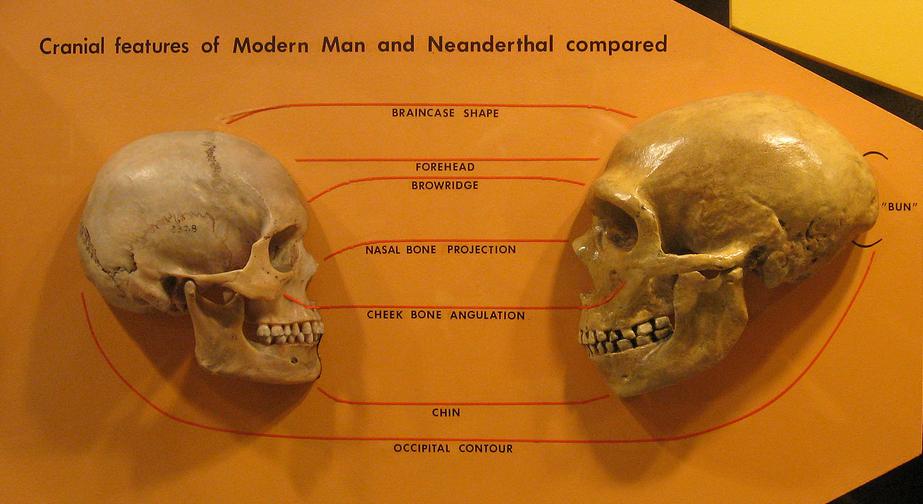Questions about bioanth topics? Contact me and #Askabioanth and I’ll answer them here and on Social Media!
Question received: “I want to know the physical characteristics that define humans and separate us from other hominins.”
First, thank you for your question! I see a few different parts to this question. We’ll first need to define what a hominin is and what general characteristics they have. Next, we’ll need to define what a human is and explore some of the characteristics different human species share. Finally, we’ll sum it all up by looking at some of the characteristics that set us apart from the other hominins. What makes modern humans modern? Let’s find out!
What is a Hominin?
A hominin is a member of the group that includes all humans and human ancestors. This group begins with an evolutionary split from the last human and ape common ancestor. This takes place roughly 7 million years ago. With this split, one branch evolved into the group that contains the chimps and the bonobos. The other branch evolved into the hominins, of which we are the last living member. You can think of hominins as being more human-like and less ape-like through time.

Hominin Characteristics
Let’s look at some of the defining characteristics of the hominins. It’s important to note that each hominin species will have some physical differences between them. For this reason, what sets us apart will depend a lot on which other hominin we are being compared to. Despite these differences, hominins as a group share a number of characteristics in common.

Some general defining characteristics of all hominins include:
- Orthograde (upright) body posture
- Bipedalism (walking on two-legs as a primary mode of locomotion)
- Nonhoning canine teeth (canine teeth that do not self-sharpen against each other)
- Expanded cranial capacity (room in the skull for a big brain)
Later hominins also show increasingly complex behavioral characteristics. This includes tool use, spoken language, and culture. These are not physical characteristics but are very important nonetheless.

Genus Homo
A genus is a group of similar and closely related species. One genus within the hominins is the genus Homo. Our own species, Homo sapiens, belongs to this genus. ‘Homo’ means ‘man’. Therefore, one could say (and I have before) that any member of the genus Homo is a human. This would mean Homo erectus, Homo heidelbergensis, and the Neanderthals among others are all humans. There is also some debate whether the earliest species of the genus, Homo habilis, belongs in our genus or not. But that’s a story for another day!
Species in genus Homo are more human-like than even the earlier hominins. Some characteristics that species in the genus Homo share include a notable increase in cranial capacity and a decrease in face and tooth size compared to the earlier hominins. Species in genus Homo are also obligate bipeds, meaning they rely exclusively on walking on two legs to get around. Earlier hominins, while bipedal, also had some tree climbing ability. Members of the genus Homo however are most at home on the ground.
The Archaic Humans
Middle Pleistocene (Ice Age) hominins, including Homo erectus, Homo heidelbergensis, and Neanderthals all form a group known as the ‘archaic humans‘. This group comes before the anatomically modern humans (that’s us). Archaic humans share all the characteristics of hominins and the characteristics of genus Homo. They also have some new features that they share with anatomically modern humans. You can think of the archaic humans as falling physically and behaviorally in between Homo erectus and anatomically modern humans.
Let’s compare archaic humans and modern humans:

There’s not a huge amount of difference separating us modern humans from the archaic human species. Cranial capacities overlap, modern limb proportions emerge with Homo erectus, and we now have a fully modern bipedal stride with the archaic humans. This means they could walk like us, and also think and possibly talk somewhat like us too.
The Archaic vs The Modern Humans
Some of the more distinct cranial features of modern humans include a smaller face with a more slender jaw and smaller teeth than found in archaic species. The cranial shape of modern humans is also more rounded, with a high vertical forehead. Archaic forms, such as the Neanderthal pictured above show a long low cranium with a slanted forehead.
Big eyebrow ridges, a more projecting face, and a pronounced occipital bun are archaic features, as seen on the Neanderthal. Modern humans in contrast have a smaller and more compact face with a projecting chin. Fun fact: we don’t entirely know why we have a projecting chin and archaic humans don’t! One theory has to do with our increasingly soft and processed diets and resulting shrinking jaw size. Check out https://bonesandbioanth.com/recent-human-evolution-right-in-your-mouth/ for more on this topic!
As far as post-cranial (from the neck down) differences, body size and limb proportions are essentially modern from Homo erectus forward. There are slight differences between different species. For example, the Neanderthals have more robust and bulky post-cranial elements. These include a broad barrel-shaped chest, larger joints, and slightly shorter limb lengths. These Neanderthal features are thought to be adaptations for living in a cold environment.
The Anatomically Modern Humans
Anatomically modern humans first arose in Africa roughly 200,000 years ago. The term ‘anatomically modern humans‘ is used to distinguish Homo sapiens from the extinct archaic forms. Modern humans have a range of physical variations, and therefore the term anatomically modern humans describes the whole expected range of human variation. Think of it this way: if you had a time machine and you transported an anatomically modern human from the past into today, you wouldn’t notice any obvious physical differences. They would look just like us!
However, behavioral modernity doesn’t happen until the late Paleolithic. During this time period, humans begin making and using more complex tools. They start creating art. They practice symbolic behaviors and abstract thought. These behaviors as a package are considered revolutionary for our species and ultimately set us apart.
To recap, some physical characteristics that set modern humans apart include:
- A high vertical forehead
- A round skull shape
- A projecting chin
- Small eyebrow ridges
- Smaller teeth
- A lighter post-cranial skeleton than other human species
And there you have it. A very quick crash course in what sets modern humans apart physically from other hominins.
Questions about bioanth topics? Contact me and #Askabioanth and I’ll answer them here and on Social Media!
Kate Keller (McElvaney)
References:
Human Characteristics https://humanorigins.si.edu/human-characteristics
